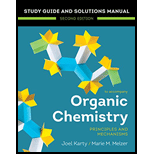
Concept explainers
(a)
Interpretation:
The product of
Concept introduction:
Deuterium is an isotope of hydrogen atom, which can be eliminated along with the leaving group in
(b)
Interpretation:
The product of
Concept introduction:
Deuterium is an isotope of hydrogen atom, which can be eliminated along with the leaving group in
Want to see the full answer?
Check out a sample textbook solution
Chapter 8 Solutions
EBK ORGANIC CHEMISTRY: PRINCIPLES AND M
- When this alkene is subjected to the conditions shown, two equivalents of a single product is formed.Draw the structure of the product that would be in the box to the rightarrow_forwardaddition of hbr to a double bond with an ether (-or) substituent occurs regiospecifically to give a product in which the Br OR are bonded to the same carbon. Draw the two possible carbocation intermediates in this electrophilic addition reaction,and explain using resonance why the observed product is formed.arrow_forward4) One of the diastereomeric cyclohexyl bromide starting materials below will readily undergo an E2 reaction while the other one will not. Fill in the requested information in boxes and lines indicated including the structure of the alkene product that does undergo an E2 reaction (use scratch paper first please). draw the expected major alkene product draw lowest E chair conformations Me. Ме Me EtO: Na Me "Ме :Br: Ме. Ме Me Me" Ме EtO: Na :Br: Required arrangement of H and LG (Br) for E2? (no acronyms). What is the rate law for and E2? On the template at left, draw all o & o* orbitals involved in the allowed E2 process.arrow_forward
- Draw the product of the E2 reaction shown below. Include the correct stereochemistry. Use a dash or wedge bond to indicate relative stereochemistry on asymmetric centers, where applicable. Ignore any inorganic byproducts. CI Strong Basearrow_forwardDraw out the mechanism in detail for the following reaction. Include all charges, arrows, intermediates, etc. If there is stereochemistry, draw it in.arrow_forwardThe transformation below takes place by two distinct reactions. Intermediate A is formed in the first reaction and then this goes on to the product in the second reaction. Provide a complete curved-arrow mechanism for all steps of both reactions.arrow_forward
- Draw the structure (including stereochemistry) of an alkyl chloride thatforms attached alkene as the exclusive E2 elimination product.arrow_forwardBe sure to answer all parts. Draw all constitutional isomers formed in the E2 reaction below and predict the major product using the Zaitsev rule. OH The tetrasubstituted product is: draw structure . The trisubstituted product is: draw structure.. The disubstituted product is: draw structure. The major product is the (select) substituted product.arrow_forwardWhich reaction in each of the following pairs would you expect to be faster? (i) Write both reactions using bond-line presentation and, using arrows providing a mechanistic explanation of the course of the reaction, draw either a transition state or an intermediate product of the reaction; (ii) Shortly (one sentence) explain your reasoning why one of the two reactions will be faster.arrow_forward
- 3. When the following deuterium-labeled compound is treated with potassium tert-butoxide in DMF, a single product is observed. When the same substrate is heated in the presence of dilute potassium ethoxide in ethanol, a mixture of two products is formed. Provide the complete, detailed mechanism (curved arrows) for each reaction and label each reaction as E1 or E2. Note: deuterium is an isotope of hydrogen and can be treated similarly to hydrogen in chemical reactions but cannot be implied. H KOEt DMF ? D H dilute KOEt EtOH ?+ ?arrow_forward7. Draw the complete, detailed mechanism (curved arrows) for each of the following reactions occurring under SN1 conditions and under SN2 conditions. Pay attention to the stereochemistry of the product. al + SN1 mechanism SN2 mechanism Br SN1 mechanism + KBr SN2 mechanism NaOH CI + NaOCH3 SN1 mechanism SN2 mechanismarrow_forwardOrganic Chemistry SUGGEST A MECHANISM FOR EACH STEP OF THE FOLLOWING TRANSFORMATION AND EXPLAINWHY THEY WORK. (TMS is trimethylsilyl). This reaction with the organolithium reagent is similar to an SN2reaction except the nucleophile is reacting at a silicon atom. Please help with problem. thank youarrow_forward
 Organic Chemistry: A Guided InquiryChemistryISBN:9780618974122Author:Andrei StraumanisPublisher:Cengage Learning
Organic Chemistry: A Guided InquiryChemistryISBN:9780618974122Author:Andrei StraumanisPublisher:Cengage Learning

